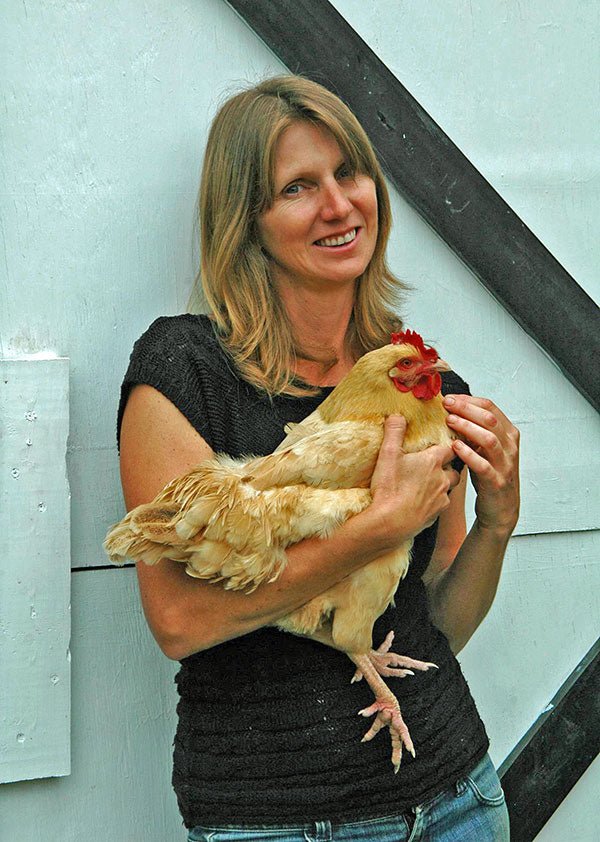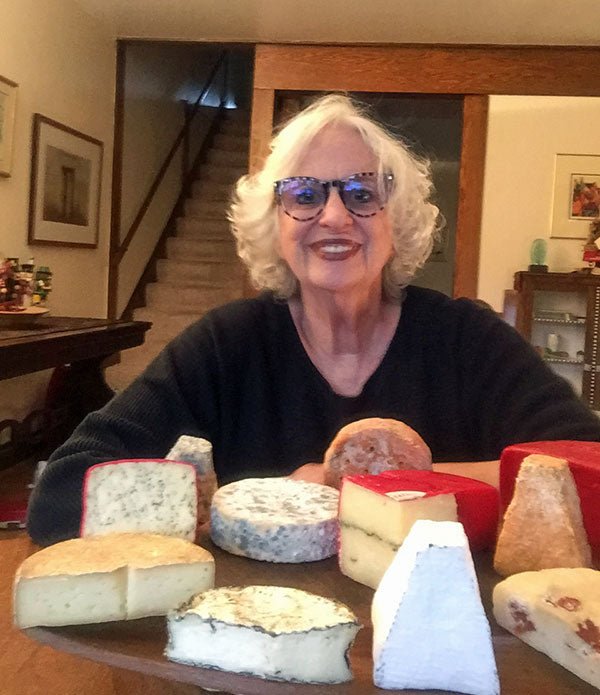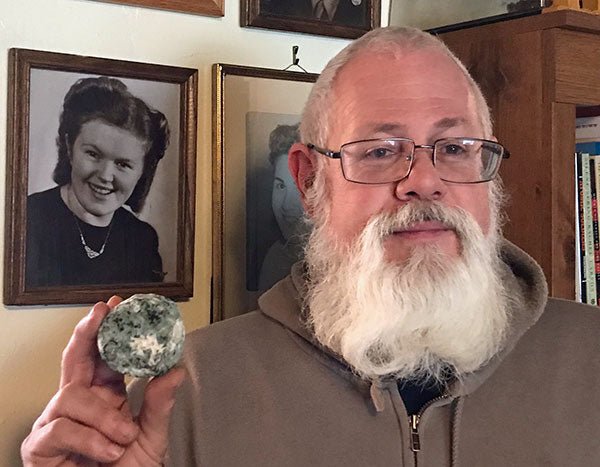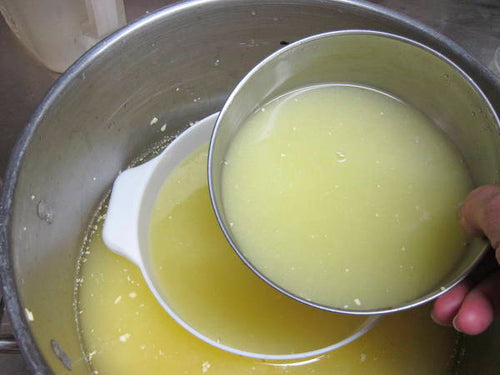
Tasha Greer
Tasha has a popular website (Simplestead.com) where she chronicles her life as a homesteader in the Blue Ridge Mountains on the border with Virginia.

Photo by Tim Miles
She and her partner (Matt Miles) use about 1 1/2 acres of their 10 acre wooded property to raise dairy goats, ducks, chickens, a pet turkey, worms (for composting), 2 dogs, 4 cats and occasionally pigs.
In 2017, Tim Miles (who Tasha calls her bon père), wrote a fascinating article for Small Farmers Journal about how and why Tasha and her partner became homesteaders (Back to the Land).

Photo by Tim Miles
She has a large vegetable garden, vineyard and spice garden and she teaches classes in edible landscaping and organic gardening.

View of garden from her back door.

Vineyard. Nobel muscadines, Cayuga White, Cabernet Sauvingon, Corot Noir, Léon Millot.

Steps to her greenhouse.

Inside the greenhouse.
As if that isn’t enough: Tasha is an expert of growing spices and she has written a fabulous book on the subject – Grow Your Own Spices. It’s a “must-have” reference book for anyone (anywhere) interested in growing their own spices.

Available online at Amazon, Thriftbooks, Target, Walmart and many more.
If you’re interested in watching a video, she did a free webinar for the Master Gardeners of North Carolina (click here).
What else? (!)
Yes, she is a cheese maker. She raises goats to make raw milk cheeses for daily eating – mostly chevre, mozzarella, haloumi, feta, semi-soft-ripened cheese, and sometimes blue cheese and cheddar.

Tiberius, a young Nigerian buck.
When we first contacted her about doing this interview, she was reluctant:
I’d love to be profiled, but I’m really just a “homestead cheesemaker.” I take the still warm from the udder and use rennet, citric acid, vinegar, or lemon juice to make cheese. Once in a while, I dabble with cultures. I periodically make simple semi-soft ripened goat loaves with MM100 and Candidum. But I never even use a thermometer. Mostly, I focus on cheeses I can make with a flour sack towel, pot, and no more than 5-10 minutes of work, including doing dishes.
I think I’m the the antithesis of the amazing cheese makers you normally profile and the incredible knowledge you are sharing with cheesemakers every where. But I might be making some more serious cheeses later this year. So if I do that, then I can get back in touch.
Needless to say, we’re not all making award-winning cheese! We adapt the process to our own unique lifestyles. We’re thrilled that Tasha decided to share her process with us.

Biography at Mother Earth News
Tasha’s Story
I grew up on Tillamook – my mom’s favorite. But in college I had a lot of international friends with broader food interests who exposed me to things like raclette, buffalo mozzarella, feta, and Manchego. Not long after that I began a relationship with the French culture and spent lots of vacations in France devouring fromage of every sort.
But it wasn’t until I read Brad Kessler’s beautiful book Goat Song that I realized I could make my own cheese. At that time, my partner Matt and I were making plans to buy a homestead somewhere and produce most of our own food. So, I started researching goats.
Of course, that search led me to Deborah Neimann’s book Raising Goats Naturally – which convinced me further that goat cheese was my future. Then, I read Barbara Kingsolver’s life-altering book – Animal, Vegetable, Miracle – including the bit about her taking a course with “The Queen of Cheese” Ricki Carroll.

From cheesemaking.com
That led to Matt buying me a cheese kit from New England Cheesemaking Supply Company for Christmas. Then, together we made our first farmhouse cheddar.
Not too long after the making of our first cheese — we moved to our homestead, started a dairy herd, and built cheese-making into part of the daily routine. So, I blame Brad, Deborah, Barbara, Ricki (who don’t even know me), and my partner Matt for my present state of not being able to live without goat milk products!
I started my herd with two Nigerians does who had already kidded so I didn’t have to wait years to get to good milk production. I picked up one of them the day her kids were weaned and got to milk her immediately. The other, I bred a month later.

I discovered that Nigerians have amazingly rich milk, but not much of it. So, I worked my way up to 8 Nigerian does in a hurry. Since Nigerians come into heat year-round, I normally stagger their milk outages and births to try target collecting a gallon of milk a day. That’s about what we need to make cheese, yogurt, drink, and for cooking for personal use and sharing some with local friends and family.
I also try to breed them only once every 1.5 to 2.5 years so I don’t have to raise and find homes for kids annually. My first milker Phoebe — who is now officially “out to pasture” — gave me 6 cups a day for over 3.5 years before I dried her off for the last time. She definitely earned her retirement!

Last fall, though, I got busy writing Grow Your Own Spices. To save time, I dried out all of my Nigerians and got myself an Alpine in milk from friend who had a dairy herd.
Abby the Alpine gave me about a gallon a day until just recently. She’d been in heavy milk for 2 years at that point and was ready for a break! Her milk isn’t good for soft-ripened cheeses, but it is amazing for mozzarella.
At the moment, I’m surviving on frozen milk. But my 7 non-retired Nigerians are pregnant. With any luck, by March, I’ll be able to drink fresh milk and start making lots of cheese again! I also want to try a Nubian goat in the not too distant future.

Wine fridge cheese cave.
Are you making cheese with your frozen milk?
I usually have fresh milk year round so this is the first time I have ever used frozen milk for drinking and I don’t have enough to use for cheese. However, I accidentally discovered that when you unfreeze goats milk by soaking your container in a bowl of hot water, the cream separates naturally.
Apparently, this has been commonly known since at least 1935, based on a paper I found about it. But it was a revelation for me!

Page one of the article. https://www.journalofdairyscience.org/article/S0022-0302(35)93146-0/pdf
With fresh cows milk, the fatty cream naturally rises to the top in no time. But with goats, milk only a fraction of the cream separates out and it tastes terrible by the time it does. So, now that I have learned this freezing/thawing trick, once I am back in regular milk I want to use it to skim off the cream and make some true triple cream type cheeses.
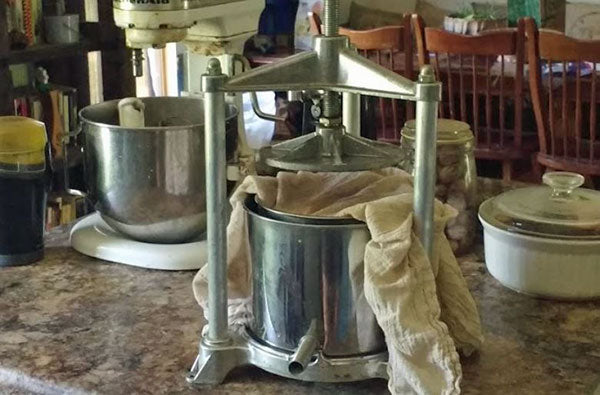
Fruit press as a cheese press.
What kind of cheese are you making most often?
I have to start by saying that I am incapable of following a recipe. I read them for inspiration and then do my own thing. None of my cheeses are traditional.
I also break a ton of food safety rules in my approach. I eat vegetables unwashed from the garden, drink raw milk daily, make mayonnaise with unpasteurized egg yolks and use it for weeks, eat sashimi whenever I can, and thoroughly enjoy steak tartare. So, I am just a food dare devil or rebel.
Now back to the question on what cheeses I make most. When my does are in milk, I make cheese almost daily. So, I have a large repertoire that I work through regularly.

We have a cob pizza oven, and except for this year, due to COVID, we normally have regular pizza nights with friends and family. So I make a ton of mozzarella-style cheese for our pizzas.
I make a raw milk, rennet only cheese that I shape into logs. It’s creamy and rich. Mix it with a stick of butter and some homemade Herbs de Provence type mix, and it will give Boursin a run for it’s money as a cracker spread. If I want to crumble it over salad like feta, I just dry it longer.

Homemade goat cheese.
I make something that tastes a whole lot like a muenster-meets-havarti using citric acid and rennet. I do it by leaving the curds in the whey until they start to feel a bit springy. After that I strain them into a loaf shape and dry them until it feels like a moist sponge. I age it for a month or so until it smells very muenster-like.
With Nigerian milk, since the fat is close to 6%, I make two soft-ripened rounds each week that I age for about 2 months. They look like a brie loaf, but taste like an aged crottin. The edges get liquidy (at room temperature) but the center stays solid. If I bake it en croute, the whole thing will ooze when cut, just like a brie.

Soft-ripened cheese
I also make ricotta to use for gnudi dumplings and desserts.
I make a paneer type cheese that I acidify with homemade whey vinegar rather than lemon juice.

Haloumi is also summer favorite for the grill.
Then there’s yogurt and yogurt-based cheese and no rennet mason jar cheese on the counter.

Mason jar cheese. I save some of the cultured milk from my cheese making the day before and add it to a mason jar of fresh milk, cover it with a coffee filter, and let it sit on the counter for a day or two until it’s cheese. Then I eat it with a spoon – kind of like a fromage blanc.
At peak milk, I make some goat cheddar and a nutty dry cheese that is a good substitute for parmesan.
Not all of my longer aged cheeses turn out because I can’t fully control the drying times. So, that’s why I focus more on short turn-around cheese.
I target a gallon a day because I make 1 gallon batches. Once in a while, I save up and do big batches. But for the most part, I spend about as much time making cheese each day as I do brushing my teeth!
My other secret to how I manage to make cheese daily is that I write from home and barely ever go anywhere. So, I’ve got more time than people who have to commute and shower … (showering is optional when you mainly see goats at work).

What are your goals for your cheese making?
There’s an incredible creamy just a few miles up the road from me called Meadow Creek in Galax, Virginia. They make this cow’s milk cheese called Mountaineer that has a profound, caramelly, nutty taste and a richness that lingers on your tongue forever. Eating it is an absolutely divine experience.

Mountaineer cheese is an award winning Alpine cheese. Photo from Heritage Harvest Farms where it’s available to buy online.
I would love to make something on a par with that, using goat milk someday. I’m probably still a few years away from being able to make cheese at that level. But I’ll keep experimenting, learning, and hopefully improving until I become the kind of cheesemaker who can pull that off.
I especially have to work on my affinage area. I don’t think you can make a cheese like that in a wine fridge. Thankfully, we have plans to put in a root cellar/cheese cave on our homestead in the future.
Websites:
Simplestead with Tasha
reLuxe renderings
Facebook:
Simplestead
Instagram:
@Exploresimplestead






























